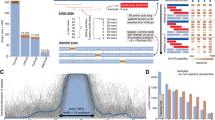Abstract
Targeting lung tissue is nonselective due in part to the lack of specific cell-surface receptors identified on target lung cells. We used in vivo phage display to identify a panel of peptides that can bind selectively to lung epithelial cells with less binding to nonepithelial cells. By direct intratracheal instillation of phage libraries into the lung, we isolated and identified 143 individual phage clones. Three phage clones revealed enhanced binding to the lung in vitro and in vivo. These three identified peptides were synthesized and demonstrated selective binding to epithelial cells in lung tissue versus the control peptide. Further, the peptides specifically bound to freshly isolated type II alveolar epithelial cells compared with Hep2 cells. The results suggest that the airway phage display approach could be exploited for analyzing the molecular diversity in the lower respiratory tract.
This is a preview of subscription content, access via your institution
Access options
Subscribe to this journal
Receive 12 print issues and online access
$259.00 per year
only $21.58 per issue
Buy this article
- Purchase on Springer Link
- Instant access to full article PDF
Prices may be subject to local taxes which are calculated during checkout







Similar content being viewed by others
References
Sorokin SP . In: Nettesheim P, Hanna Jr MG, Deatherage JW (eds). Morphology of Experimental Respiratory Carcinogenesis. US Atomic Energy Commission, Gatlinburg, TN, 1970; pp. 3–44.
Look DC, Brody SL . Am J Respir Cell Mol Biol 1999; 20: 1103–1106.
Curiel DT, Pilewsky JM, Albelda SM . Am J Respir Cell Mol Biol 1996; 14: 1–18.
Albelda SM, Wiewrodt R, Zuckerman JB . Ann Intern Med 2000; 132: 649–660.
Kaner RJ et al. Am J Respir Cell Mol Biol 1999; 20: 361–370.
Crystal RG et al. Nat Genet 1994; 8: 42–51.
Kolls JK et al. Alcohol Clin Exp Res 1998; 22: 157–162.
Wu M et al. Proc Natl Acad Sci USA 2001; 98: 14589–14594.
Wu M et al. Am J Respir Crit Care Med 2002; 166: 192–199.
Scott JK, Smith GP . Science 1990; 249: 386–390.
Berardinis PD et al. Nat Biotechnol 2000; 18: 873–876.
Brown KC . Curr Opin Chem Biol 2000; 4: 16–21.
Li M . Nat Biotechnol 2000; 18: 1251–1256.
Pasqualini R, Ruoslahti E . Nature 1996; 380: 364–366.
Rajotte D et al. J Clin Invest 1998; 102: 430–437.
Parmley SF, Smith GP . Adv Exp Med Biol 1989; 251, 215–218.
Skillrud DM, Martin II WJ . Am Rev Respir Dis 1984; 129: 995–999.
Skillrud DM, Martin II WJ . Lung 1984; 162: 245–252.
Wu M, Kelley MR, Hansen WK, Martin II WJ . Am J Physiol Lung Cell Mol Physiol 2001; 280: L755–L761.
Weaver T et al. J Immunol Methods 1996; 193: 149–156.
Coligan JE, Kruisbeek AM, Shevach EM, Strober W . Current Protocols in Immunology, John Wiley & Sons, Inc., New York, 1992.
Wu M, Brown WL, Stockley PG . Bioconjugate Chem 1995; 6: 587–595.
Ladner RC . Trends Biotechnol 1995; 13: 426–430.
Bonnycastle LLC et al. J Mol Biol 1996; 258: 747–762.
Altschul SF et al. Nucl Acids Res 1997; 25: 3389–3402.
Samoylova TI, Smith BF . Muscle Nerve 1999; 22: 460–466.
Rajotte D, Ruoslahti E . J Biol Chem 1999; 274: 11593–11598.
Kolonin M, Pasqualini R, Arap W . Curr Opin Chem Biol 2001; 5: 308–313.
Arap W et al. Nat Med 2002; 8: 121–127.
Trepel MF, Grifman M, Weitzman MD, Pasqualini R . Hum Gene Ther 2000; 11: 1971–1981.
Acknowledgements
We are grateful to Dr G Smith of the University of Missouri for the phage peptide libraries. We thank M Brown, T Evanoff, JR Wagner, M Goheen, and Z Zhu for technical help. This work was supported by National Institutes of Health Grants NCI PO1-CA75426, RO1 AI48455, and R21 HL72363.
Author information
Authors and Affiliations
Rights and permissions
About this article
Cite this article
Wu, M., Pasula, R., Smith, P. et al. Mapping alveolar binding sites in vivo using phage peptide libraries. Gene Ther 10, 1429–1436 (2003). https://doi.org/10.1038/sj.gt.3302009
Received:
Accepted:
Published:
Issue Date:
DOI: https://doi.org/10.1038/sj.gt.3302009
Keywords
This article is cited by
-
Pseudomonas aeruginosa infection augments inflammation through miR-301b repression of c-Myb-mediated immune activation and infiltration
Nature Microbiology (2016)
-
Discovery of a Biological Mechanism of Active Transport through the Tympanic Membrane to the Middle Ear
Scientific Reports (2016)
-
Annexin A2 binds to endosomes and negatively regulates TLR4-triggered inflammatory responses via the TRAM-TRIF pathway
Scientific Reports (2015)



